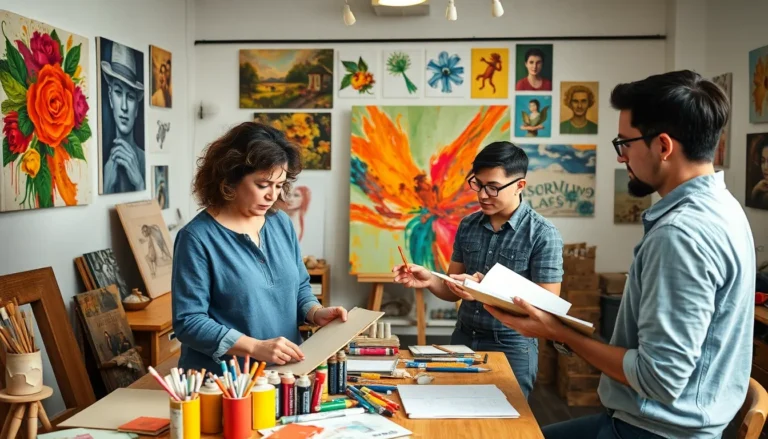Table of Contents
ToggleIn the world of creativity, brainstorming is the secret sauce that transforms wild ideas into brilliant solutions. But let’s be honest—sometimes it feels more like herding cats than generating genius. With the right strategies, though, anyone can turn a chaotic cloud of thoughts into a rainbow of possibilities.
Overview of Brainstorming Strategies
Brainstorming strategies provide structured approaches for generating ideas effectively. Diverse methods cater to various preferences, enhancing creativity within teams. Each technique focuses on unleashing innovative potential through collaboration and guidance.
Mind Mapping encourages visual representation of thoughts. Participants start with a central idea and branch out into related concepts. This method supports connections between ideas, fostering deeper understanding.
Brainwriting creates individual idea generation in a written format. Team members jot down ideas silently, passing their papers to others for further development. This process minimizes groupthink and ensures everyone’s contributions matter.
Rapid Ideation involves setting time limits for idea generation. A fast-paced environment encourages participants to think quickly, resulting in a plethora of ideas without overanalysis. This technique generates a rich pool of possibilities in a short period.
SCAMPER is a technique focusing on seven prompts: Substitute, Combine, Adapt, Modify, Put to another use, Eliminate, and Reverse. Each prompt stimulates creative thinking by challenging existing concepts.
Role Storming allows participants to adopt different personas during brainstorming sessions. By stepping into someone else’s shoes, individuals gain unique perspectives, enhancing the overall quality of ideas generated.
Brain Dumping invites participants to write down all ideas freely. This unfiltered approach encourages spontaneous thoughts, allowing for later refinement. It’s particularly useful when participants feel stuck or overwhelmed.
Online Collaboration Tools facilitate remote brainstorming efforts. Platforms like Trello or Miro enable teams to share ideas in real-time. This technology supports various strategies, making distance less of a barrier for creativity.
Implementing these diverse brainstorming strategies empowers groups to maximize their potential for innovative solutions. Using structured methods, individuals harness their thoughts effectively, overcoming challenges associated with idea generation.
Importance of Brainstorming in Creativity

Brainstorming plays a vital role in the creative process, serving as a springboard for innovative exploration. It transforms disorganized thoughts into structured ideas and cultivates an environment where creativity thrives.
Enhancing Idea Generation
Enhanced idea generation emerges from effective brainstorming techniques. Techniques like Mind Mapping visualize thoughts, making complex ideas easier to digest. Rapid Ideation encourages spontaneous thinking, allowing participants to capture ideas quickly under time constraints. Brainwriting fosters individual reflection before sharing, ensuring all voices contribute. Focus on diverse approaches helps participants break free from conventional boundaries, leading to the birth of fresh concepts. Diversity in ideas catalyzes unique solutions that can address problems from various angles.
Collaboration and Team Dynamics
Collaboration strengthens team dynamics during brainstorming sessions. Role Storming ignites creativity by allowing participants to assume different personas, revealing insights that enhance collective problem-solving. Online Collaboration Tools bridge geographical gaps, enabling teams to work together effectively regardless of location. Together, these strategies promote a culture of inclusivity, encouraging every team member to share ideas confidently. Building this sense of belonging not only boosts morale but also amplifies the quality of contributions, creating a robust pool of innovative ideas.
Popular Brainstorming Techniques
Creative brainstorming techniques enhance the ideation process, providing structured methods to effectively generate innovative solutions. Here are several popular strategies.
Mind Mapping
Mind Mapping offers a creative way to organize thoughts visually. It involves placing the central idea at the center of a diagram, with related concepts branching out. Users find this technique especially useful for breaking down complex topics into manageable parts. Participants benefit from seeing connections between ideas, which fosters deeper understanding. Tools for Mind Mapping include software like XMind and FreeMind, making it accessible for both individuals and teams. This technique encourages nonlinear thinking, allowing for spontaneous insights.
Brainwriting
Brainwriting encourages silent contribution of ideas before group discussion. Participants write their thoughts down on paper or digitally, ensuring everyone can share without interruptions. This method boosts engagement and minimizes the pressure of immediate verbal communication. Over time, it often leads to more diverse perspectives and refined concepts. Many adopt this technique to gather initial responses, which can then be built upon in later discussions. Teams can set specific time limits for each round to keep the process dynamic and efficient, thereby maximizing creativity.
Role Storming
Role Storming involves assuming different personas to inspire fresh ideas. By stepping into another character’s shoes, participants explore diverse viewpoints. This method enhances empathy and broadens the range of generated concepts. For instance, a team might take on roles like customer, competitor, or even a historical figure to challenge existing assumptions. This technique often leads to unexpected insights that drive innovation. Adopting distinct perspectives helps individuals think outside conventional boundaries, enriching the brainstorming process and fostering originality.
Tips for Effective Brainstorming
Creating an optimal environment and fostering participation are essential to successful brainstorming sessions.
Setting the Right Environment
A comfortable atmosphere promotes creativity. Adjust lighting and reduce noise to enhance focus. Use tools like whiteboards or sticky notes to encourage visual representation of ideas. Arrange seating to facilitate collaboration, ensuring participants can engage easily. Include plants or artwork to stimulate inspiration. Creating a positive space encourages candid expression and an open exchange of thoughts.
Encouraging Participation
Encouraging everyone to share ideas promotes diverse perspectives. Implement techniques like round-robin sharing to ensure equal contribution. Break larger groups into smaller teams for focused discussions. Recognize and celebrate each contribution, fostering a supportive culture. Utilize icebreaker activities to ease tension and create rapport among participants. Keeping the environment inclusive enhances engagement, leading to a richer pool of ideas.
Harnessing effective brainstorming strategies can significantly elevate the creative process. By embracing diverse techniques like Mind Mapping and Brainwriting, individuals and teams can unlock new perspectives and generate a wealth of innovative ideas.
Creating an optimal environment that encourages participation and collaboration is essential for maximizing creativity. With the right tools and a supportive atmosphere, teams can transform chaotic thoughts into structured solutions.
Ultimately, the power of brainstorming lies in its ability to break down barriers and foster a culture of inclusivity, enabling groups to tackle challenges with confidence and creativity.







